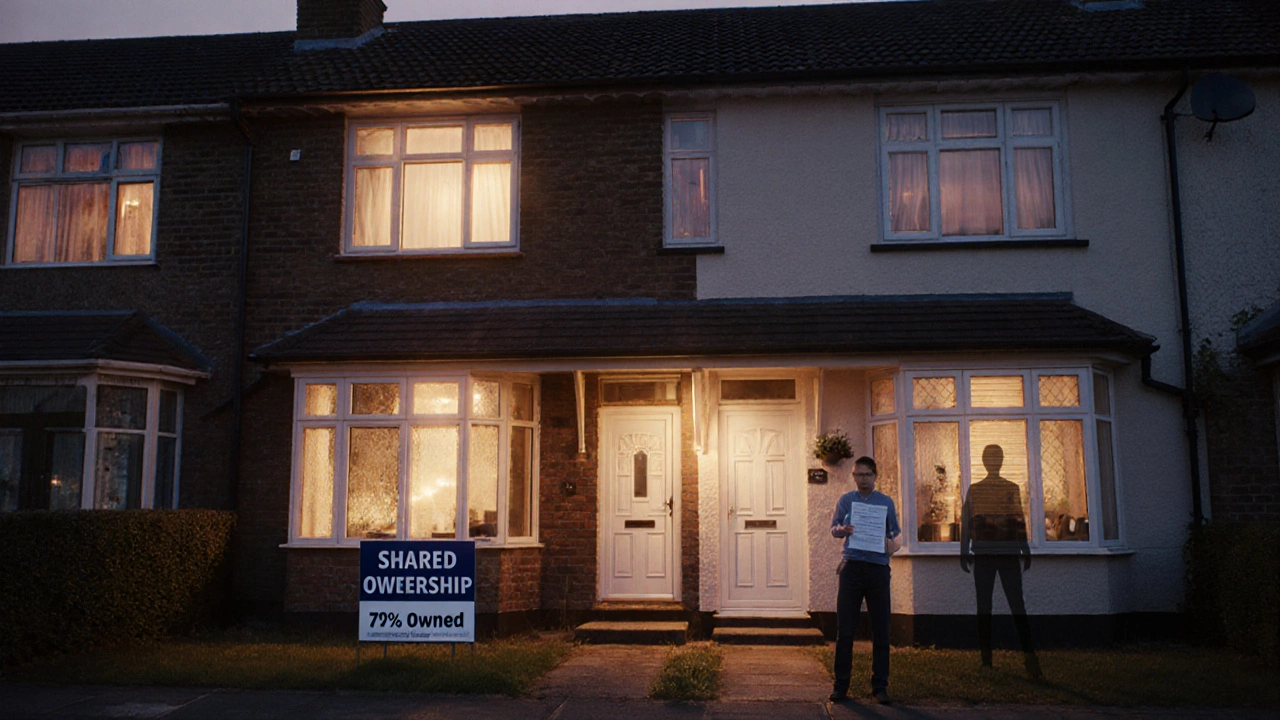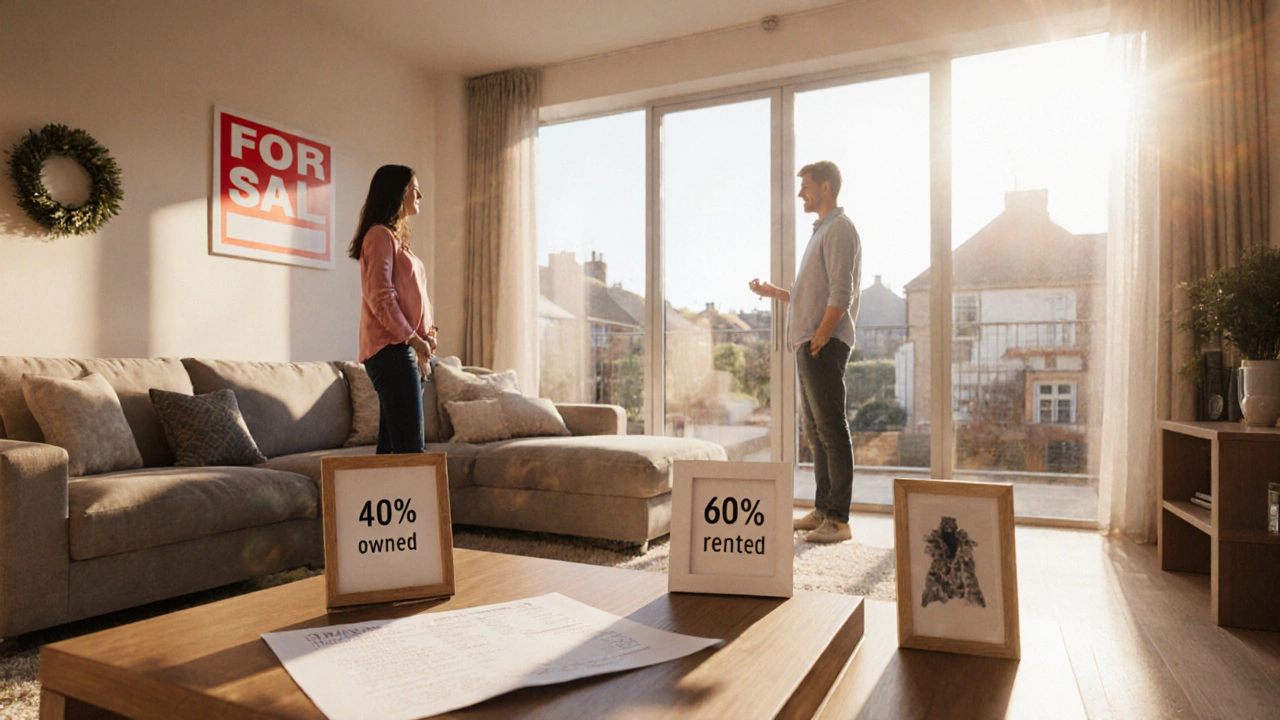Shared Ownership Calculator
Your Current Share Value
Your Monthly Rent
Rent is calculated on the portion you don't own (100% - your share)
Staircasing Calculation
Includes estimated costs (valuation $500, solicitor $1,200)
When you buy a shared ownership home, you’re not buying the whole house. You’re buying a portion of it-usually between 25% and 75%-and paying rent on the rest. That’s the whole point: to get your foot on the property ladder without needing a full mortgage. But figuring out how much you actually own, how much you’re paying for it, and how to buy more later? That’s where things get messy. Most people don’t realize how the math works until they’re halfway through the process. Here’s how it actually works, step by step.
What Exactly Is Your Share?
Your share is the percentage of the home’s value you own. If you buy a 50% share in a house priced at $500,000, you pay $250,000 upfront. The housing association or developer owns the other half. You pay rent on that half-usually around 2.75% to 3% per year of the unsold portion. So in this case, you’d pay rent on $250,000. That’s about $6,875 a year, or $573 a month.
This isn’t like renting from a landlord. You’re a part-owner. You can fix up your place, hang pictures, even get a pet-if the rules allow it. But you’re still paying rent on the part you don’t own. And if you want to own more later, you have to buy additional shares. That’s called staircasing.
How to Calculate Your Current Share
To know what you own right now, you need two numbers: the original purchase price of the home and the percentage you bought. Multiply them together.
Example: You bought a 40% share in a home that cost $450,000 when you signed the contract.
- 40% × $450,000 = $180,000
That’s your equity. You own $180,000 worth of the property. The rest-$270,000-is still owned by the housing provider. Your rent is calculated on that $270,000.
But here’s the catch: the home’s value might have changed since you bought it. If the house is now worth $550,000, your 40% share isn’t worth $180,000 anymore-it’s worth $220,000. That’s important because when you staircase, you’ll pay based on the current market value, not the original price.
How Staircasing Works
Staircasing means buying more shares. You can usually buy in increments-10%, 15%, 25%-until you own 100%. Some schemes let you go all the way to full ownership. Others cap you at 80% or 90%. Check your lease.
Let’s say you own 40% of a home that was originally $450,000. Now it’s valued at $550,000. You want to buy another 25%.
- Current value: $550,000
- 25% of $550,000 = $137,500
You need to pay $137,500 to increase your ownership from 40% to 65%. You’ll also need a valuation from a RICS-registered surveyor. The housing provider picks the surveyor. You pay for it-usually between $300 and $600.
After you pay, your rent drops. Before: you paid rent on 60% of $550,000 = $330,000. After: you pay rent on 35% of $550,000 = $192,500. That’s a big drop in monthly rent.
What Happens When You Own 100%?
If your scheme allows full ownership, you can buy the last chunk. You’ll pay the current market value of the remaining share. Once you own it all, you stop paying rent. You’re just a regular homeowner. You still have to follow your lease terms for a while-like getting permission for major renovations-but you no longer answer to a housing provider.
Some people get stuck at 80% because the cost to buy the last 20% is too high. A home worth $600,000 means the final 20% is $120,000. That’s a huge lump sum. Not everyone can afford it. That’s why some buyers plan to stay at 75% or 80% and rent out a room to cover the rent.

How Rent Is Calculated
Rent isn’t arbitrary. It’s usually 2.75% to 3% of the unsold share per year. Most providers use 3%.
Example: You own 60% of a $500,000 home. That means 40% is still owned by the provider.
- 40% × $500,000 = $200,000 (unsold share)
- 3% of $200,000 = $6,000 per year
- $6,000 ÷ 12 = $500 per month
That rent is reviewed annually. It usually goes up with inflation-often tied to the Retail Prices Index (RPI). So if inflation is 4%, your rent might jump by 4% next year. You’ll get written notice before the increase.
What You Can’t Ignore: Fees and Costs
Every time you staircase, there are costs:
- Valuation fee: $300-$600
- Solicitor fees: $800-$1,500
- Land Registry fee: $20-$1,000 depending on price
- Mortgage arrangement fee (if you need to borrow more): $0-$2,000
Some providers charge an admin fee too-sometimes $250. That adds up. If you staircase twice, you could pay over $3,000 in fees alone. That’s why many people wait until they’re ready to buy a big chunk-like going from 50% to 80%-instead of small 10% steps.
When You Can’t Buy More
Not everyone can staircase. You need to qualify:
- Your income must still meet the provider’s affordability rules
- You must pass a credit check
- You can’t have missed rent or service charge payments
- You can’t have taken out a second mortgage without permission
Some people try to staircase but get turned down because their income dropped after a job loss. Others get stuck because they can’t get a mortgage big enough to cover the next share. That’s why it’s smart to talk to a mortgage broker who knows shared ownership schemes before you buy your first share.

What Happens If You Sell?
If you decide to move, you can sell your share. The housing provider has the right to find a buyer first. They’ll market it to other shared ownership buyers for 8 weeks. If no one buys it, you can sell it on the open market.
You get 100% of the profit from your share. If you own 60% and the home sells for $580,000, you get 60% of $580,000 = $348,000. You don’t pay the provider anything extra. But you’ll pay solicitor fees and estate agent fees if you sell on the open market.
Important: You don’t get a share of the provider’s portion. They keep their 40%. That’s why some people say shared ownership isn’t a great long-term investment. You’re only building equity on what you own-not the whole house.
Real-World Example: A Family in Auckland
Emma and Liam bought a 50% share in a three-bedroom house in Ōtāhuhu in 2023. The home cost $720,000. They paid $360,000 for their half. Rent on the other half was $18,000 a year ($1,500/month).
Two years later, the home is worth $840,000. They want to buy another 25%, bringing them to 75%. Here’s the math:
- 25% of $840,000 = $210,000
- Valuation fee: $500
- Solicitor fees: $1,200
- Total cost: $211,700
After buying, their rent drops from $1,500 to $375/month because they now own 75%-so they’re only renting 25% of $840,000 = $210,000. 3% of $210,000 = $6,300/year = $525/month. But wait-they’re still paying $375? Why?
Because their provider charges rent based on the original valuation until the next review. That’s normal. They’ll pay $525 next year. But even now, they’re saving $1,125 a month in rent. That’s $13,500 a year. That money can go into their savings for the final 25%.
Final Tip: Know Your Lease
Every shared ownership scheme is different. Your lease is the rulebook. It tells you:
- What’s the minimum share you can buy?
- What’s the maximum you can own?
- How often can you staircase?
- Are there fees for staircasing?
- How is rent calculated?
- Can you sublet?
Read it. Keep it. Ask questions before you sign. Don’t assume it’s the same as someone else’s scheme. What works in Wellington might not work in Dunedin. What’s allowed in Auckland might be restricted in Hamilton.
Shared ownership isn’t magic. It’s a tool. Used right, it gets you into a home you couldn’t otherwise afford. Used wrong, it traps you in rent payments you can’t escape. Know the math. Know your rights. And don’t let anyone tell you it’s simple-it’s not. But it’s doable if you understand the numbers.
Can I buy 100% of a shared ownership home?
Yes, in most cases-but not always. Many shared ownership schemes allow you to staircase all the way to 100% ownership. However, some providers cap ownership at 80% or 90%. You must check your lease. Even if full ownership is allowed, you’ll need to qualify for a mortgage large enough to cover the final share, which can be tens of thousands of dollars.
How often can I buy more shares?
Most providers let you staircase once a year, but some allow it every two years. You usually need to wait at least 12 months after your last purchase. Some schemes also require you to have owned your initial share for a minimum period-often two years-before you can buy more. Always check your lease for exact rules.
Do I pay stamp duty on shared ownership purchases?
In New Zealand, there is no stamp duty. However, you may pay land transfer fees when you buy your initial share or staircase. These fees are based on the purchase price of the share you’re buying, not the full property value. For example, buying a $200,000 share triggers a fee based on $200,000, not the full $500,000 home value.
What happens if my home’s value drops?
If your home loses value, your share is worth less-but you don’t owe money back. You still own the same percentage. If you bought a 50% share when the home was worth $600,000, you paid $300,000. If the home drops to $500,000, your share is now worth $250,000. You’re down $50,000 on paper, but you don’t pay the provider anything. You can still staircase based on the new value, but you’ll pay less to buy more shares.
Can I get a mortgage for shared ownership?
Yes, but not all lenders offer shared ownership mortgages. You need a specialist lender who understands the model. They’ll lend you a percentage of your share’s value-not the full home price. For example, if you’re buying a 40% share worth $200,000, they might lend you up to 95% of that ($190,000). You’ll need a 5% deposit on your share, not on the whole property.


Corbin Fairweather
I am an expert in real estate focusing on property sales and rentals. I enjoy writing about the latest trends in the real estate market and sharing insights on how to make successful property investments. My passion lies in helping clients find their dream homes and navigating the complexities of real estate transactions. In my free time, I enjoy hiking and capturing the beauty of landscapes through photography.
view all postsWrite a comment